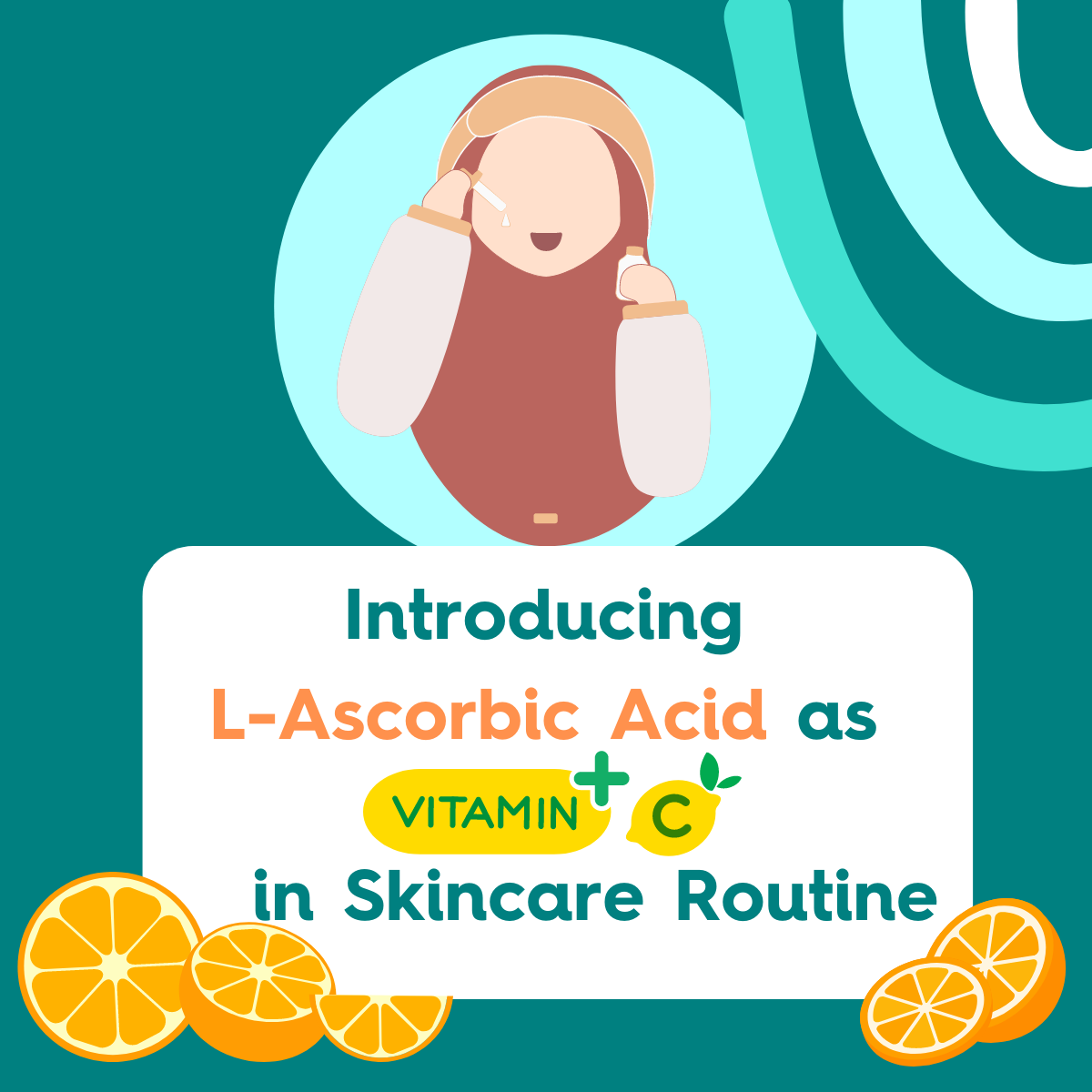When it comes to Vitamin C, the most common thing that would cross your mind would be the citrus fruits that would supply the vitamin into your body. Not only that, some of you may even consume this Vitamin as a supplement just to ensure your body receives enough of it. While this vitamin is often associated with the immune immunity system of the body, researchers have discovered that when it comes to healthy skin, topical Vitamin C is significantly more effective than consuming it.
Some of you may already have the knowledge about the goodness of Vitamin C but how familiar are you with L-Ascorbic Acid?
What is L-Ascorbic Acid?

L-Ascorbic Acid (LAA) is a pure form of Vitamin C and the “L” at the front of the name refers to how the chemical structure rotates itself when exposed to light. Derived synthetically or naturally from the resources such as fruits and vegetables; LAA is certified by researchers as one of the most trusted active ingredients in skincare products.
LAA is the only bioavailable pure form of Vitamin C that can be recognized and utilized right away by your skin. Hence, this super concentrated and potent molecule would work immediately and supply all the benefits needed by your skin.
How does L-Ascorbic Acid works on your skin?
Working as the Vitamin C for your skin, it is undeniable that this vitamin possessed a lot of benefits. L-Ascorbic Acid will penetrate the skin tissues and boost collagen production, increasing the firmness of the skin. This rejuvenating vitamin also plays a part in the reduction of photo-damage caused by harmful UVB rays and thus benefitting greatly for conditions such as ageing skin, hyperpigmentation and post-inflammation hyperpigmentation.
Is a higher concentration of L-Ascorbic Acid better?

L-Ascorbic Acid is often found in topical skincare products with a range of concentrations between 3% - 20%. While it’s a highly effective form of Vitamin C, it must be formulated at pH levels less than 3.5 to enter the skin. One thing you should remember about Vitamin C is that higher concentration doesn’t mean it is more effective. The maximal concentration for optimal percutaneous absorption was 20%. Higher concentration may irritate and purge your skin, causing it to react through sensitive bumps and itchiness.
L-Ascorbic Acid for Beginners
Do a patch test before full application
Due to the nature of low pH to stabilize L-Ascorbic Acid, you can test your skin sensitivity with patch testing by applying a small amount of this vitamin on your neck before full application on your face. Some minor tingling is normal but if the itchiness is getting intense, you should stop and switch to other forms of Vitamin C
Introduce L-Ascorbic Acid to your skin slowly
If you are unsure of how far your skin's tolerance with L-Ascorbic Acid is, you can always start by applying this form of Vitamin C with the lowest concentration of 5% -10% and increase it slowly after a few applications as your skin adjusts to it.
Store L-Ascorbic Acid in the fridge and avoid sunlight
Just like how you should be careful when dealing with a sensitive friend who had unstable emotions, it is the same case with L-Ascorbic Acid. LAA degrades easily upon exposure to high temperatures and contact with light and air. You should store it inside the fridge in order to preserve its stability. If you store it incorrectly, it would oxidize and cause it to be changed in colour. Not only that, it might affect the consistency as well.
L-Ascorbic Acid is applicable in both day and night
Since L-Ascorbic Acid is known for its antioxidant properties as well as the ability to fight off free radicals and prevent sun damage, you may assume this ingredient as the armour on your skin during the day. Meanwhile, if you encounter this ingredient in your night skincare products or simply because your skin has a high tolerance for it, feel free to do so as it may reverse the damage to your skin from the day’s work.
Vitamin C with L-Ascorbic Acid for Beginners
If you have no experience with L-Ascorbic Acid and you are not sure if the products could work for you, here are some suggestions of the Vitamin C from Worthee Cosmetics to you:-
The Ordinary Ascorbic Acid 8% + Alpha Arbutin 2% is one of the most hyped-up products for this ingredient. This water-free serum with highly-stabilized formula incorporates professionally two of the well-studied brightening ingredients in the beauty world as the perfect combo for radiant and healthy-looking skin.

Bffect Kira Glow Serum with 9% Vitamin C + E + Ferulic Acid has been a skincare classic combo that regulates melanin generation, fights free radicals and shields skin from contaminants from the environment. All you need to do is to apply a few drops a day for healthy, energized and rejuvenated skin.

Timeless 10% Vitamin C + E Ferulic Acid Serum is boasting an incredible yet moderate-strength active Vitamin C formula, this serum resets and brightens uneven skin tone visibly, day after day. Formulated with extra sensitive skin in mind, this serum suits Vitamin C beginners ideally for a daily boost of radiance and youthful-looking complexion.

References
Ahmad, I., Sheraz, M. A., Ahmed, S., Shaikh, R. H., Vaid, F. H., ur Rehman Khattak, S., & Ansari, S. A. (2011). Photostability and interaction of ascorbic acid in cream formulations. AAPS PharmSciTech, 12(3), 917–923. https://doi.org/10.1208/s12249-011-9659-1
Al-Niaimi, F., & Chiang, N. (2017). Topical Vitamin C and the Skin: Mechanisms of Action and Clinical Applications. The Journal of clinical and aesthetic dermatology, 10(7), 14–17.
Eunmi Lee, Kyusik Kim, Moonjae Choi, Youngmoo Lee, Jin-Won Park & Bumsang Kim (2010) Development of smart delivery system for ascorbic acid using pH-responsive P(MAA-co-EGMA) hydrogel microparticles, Drug Delivery, 17:8, 573-580, DOI: 10.3109/10717544.2010.500636
Lin, F. H., Lin, J. Y., Gupta, R. D., Tournas, J. A., Burch, J. A., Selim, M. A., Monteiro-Riviere, N. A., Grichnik, J. M., Zielinski, J., & Pinnell, S. R. (2005). Ferulic acid stabilizes a solution of vitamins C and E and doubles its photoprotection of skin. The Journal of investigative dermatology, 125(4), 826–832. https://doi.org/10.1111/j.0022-202X.2005.23768.x
Nusgens, B. V., Humbert, P., Rougier, A., Colige, A. C., Haftek, M., Lambert, C. A., Richard, A., Creidi, P., & Lapière, C. M. (2001). Topically applied Vitamin C enhances the mRNA level of collagens I and III, their processing enzymes and tissue inhibitor of matrix metalloproteinase 1 in the human dermis. The Journal of investigative dermatology, 116(6), 853–859. https://doi.org/10.1046/j.0022-202x.2001.01362.x
Pinnell, S. R., Yang, H., Omar, M., Monteiro-Riviere, N., DeBuys, H. V., Walker, L. C., Wang, Y., & Levine, M. (2001). Topical L-ascorbic acid: percutaneous absorption studies. Dermatologic surgery: official publication for American Society for Dermatologic Surgery [et al.], 27(2), 137–142. https://doi.org/10.1046/j.1524-4725.2001.00264.x


